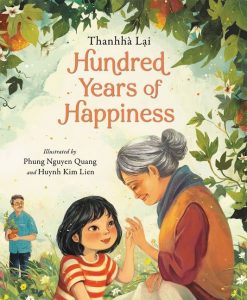 Hundred Years of Happiness
Hundred Years of Happiness
Written by Thanhhà Lại
Illustrated by Phung Nguyên Quang and Huynh Thi Kim Liên
HarperCollins, 2022, 32 pp (unpaged)
ISBN: 9780063026926
Thanhhà Lại draws on the relationship of her own mother and daughter to tell the story of An and her grandfather Ȏng’s efforts to bring back a memory to her grandmother Bà. An greets her grandparents every day in Vietnamese. She sings familiar songs to Bà to help her stay present, but after a while “a blankness claims her expression and a thin smoke clouds her eyes.” While Bà may not be able to describe her snack as a persimmon or remember An, one thing she never forgets is Ȏng. “The two of them are always next to each other, breaths swirling into one.” An and Ȏng take on a project of helping Bà remember her wedding in Vietnam through tasting her favorite dish from that special day. Traditionally, Vietnamese relatives serve xôi gấc and wish newlyweds to have a hundred years of happiness. Ȏng hopes the special dish will help his wife untangle her memories and remember their wedding. An and Ȏng patiently wait for the wrinkly gấc seeds to arrive, and then carefully sprout them, plant them, and watch them grow and mature into spiky globes. After they harvest the fruit, they cook the fruit with rice, and after burning the first attempts, make xôi gấc and serve it to Bà. As she takes bites of the red sticky rice, the smoke dissipates for a short time from her eyes and she remembers the wish for a hundred years of happiness. An and Ȏng are thrilled, and encouraged to start sprouting more seeds to help Bà remember again.
Thanhhà Lại has written two of her novels in the rhythm of Vietnamese poetry. This picurebook uses a similar poetic cadence to highlight the emotions of An and her grandfather as they try to help Bà keep her memories from fading. The love between An and her grandparents is palpable, as is the long-lasting love between Bà and Ȏng. The months that An and Ȏng work to grow the gấc fruit reflect the long love affair of Bà and Ȏng that began as children as they crafted turtles from the gấc seeds. Ȏng tries many foods, photographs, and stories to help his wife remember, and finally tries the special dish served at their wedding, recalling the vow he made on their wedding day to sweat and plan to fulfill their relatives’ wish for their happiness. When asked about the focus on food, Thanhhà Lại explains in an interview that “Memories return easiest on the tongue, which records what tastes good, whom we were with, the feelings of warmth and satisfaction. Memories flood the tongue, glide down to the heart, rise up to a smile, all without saying a word” (Shim, 2022). So it was a natural decision to use red sticky rice, a dish served at Tet and other special occasions, to help Bà remember her wedding and her family.
Along with the poetic language, the digitally-created illustrations add layers to the story. The team of Vietnamese illustrators use motifs from Vietnamese culture to convey the strong sense of history and place within a family. Spreads depict not only their current home, but also the family celebration of a wedding. The double-page spread that depicts Bà as she eats the red sticky rice, with smoke fading from her eyes, has cameos nestled in the leaves and flowers of the gấc vine, showing Bà and Ȏng as children, young adults, and newlyweds at their wedding.
Titles that would pair well with this story highlight the efforts that family members or friends go through to help elderly people remember. Mem Fox and Julie Vivas (1985) wrote and illustrated the classic Wilfred Gordon McDonald Partridge in which a young boy tries to help 96-year-old Miss Nancy regain her memories. Newer titles include The Remember Balloons written by Jessie Oliveros, illustrated by Dana Wulfekotte (2018) and Dad’s Camera by Ross Watkins, illustrated by Liz Anelli (2018). Other book pairs include titles that feature memories brought on through tasting particular dishes. Linda Sue Park and Ho Baek Lee (2005) wrote about the warm family time around a table in Bee-bim Bop! in a Korean-American home. Ohana Means Family (Loomis & Pak, 2022) portrays the process of growing taro to make poi, a traditional food served at Hawaiian luaus.
Thanhhà Lại was born in Vietnam and currently lives in New York. Her verse novel Inside Out & Back Again (2011) won the National Book Award and a Newbery Honor, and is a fictionalized account of her family’s journey from Vietnam to Alabama and adaptation to life in the United States. The sequel is When Clouds Touch Us (2023). She also wrote about reverse cultural adaptation in Listen Slowly (2015) and the language learning process in Butterfly Yellow (2019). More information can be found on her website.
Phung Nguyên Quang and Huynh Thi Kim Liên are two author-illustrators from Vietnam who work under the pen name KAA. Their collaborations have won numerous awards (e.g., CBC Notable Social Studies Trade Books for Young Readers). The stunning My First Day (2021) chronicles the trip in a small boat taken across the Mekong Delta by a young boy on his way to school, a visual feast of the beauty of the Vietnamese landscape. Their vivid action-packed style has also illustrated legends from the Eastern and Western world, and real life adventures like The Floating Field: How a Group of Thai Boys Built Their Own Soccer Field (Scott Riley, 2021).
References
Shim, Y., 2022. We Need Diverse Books. Q&A With Thanhhà Lại, Hundred Years of Happiness. https://diversebooks.org/qa-with-thanhha-lai-hundred-years-of-happiness/
Susan Corapi, Trinity International University
© 2023 by Susan Corapi

